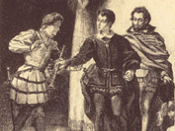Hamlet - Truth Behind a Veil of Falsities
Hamlet, an extremely famous play by William Shakespeare, is an ever challenging piece that begs the fatal question of truth or lies. Shakespeare's characters constantly shift from sanity to insanity and good to evil. By creating shuffling characters, Shakespeare is able to keep his audience thinking until the very last moment of the play, when most of the veils are lifted. The theme of appearance versus reality is set off in the beginning of the play with Claudius' murder of his brother, continues with Rosencrantz and Guildenstern, and ends with Hamlet's veil of insanity to protect himself from inquiring eyes.
Claudius is a prime example in the play of Hamlet that uses a veil of lies to cover his true intentions. Claudius firstly murders his brother with poison to become the king. He then hides the fact that he was his brother's murderer and goes on to marry Gertrude, his sister-in-law.
Obviously, Claudius shows the other characters one thing, but the audience knows that he means otherwise. Near the finale of Hamlet, Claudius can no longer bear his sins, but cannot come to terms with them, as he is "still possessed of those affects" that he performed the murder for. At this point in the play, Claudius realizes his wrongdoings, but is unable to clear himself of sin so he decides to continue his charade of a joyful appearance.
Rosencrantz and Guildenstern have both known Hamlet for a long period of time, and are, in Hamlet's point of view, his friends. However, when the King commands the pair to take Hamlet to England to have him killed, they obey. In doing so, Rosencrantz and Guildenstern are masking their true intentions with yet another veil of lies and untruthfulness. Hamlet, unfortunately...


